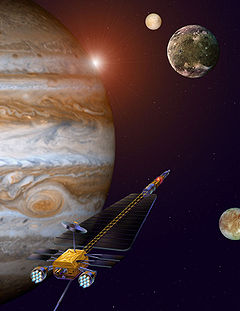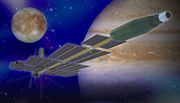
Jupiter Icy Moons Orbiter
Encyclopedia

Spacecraft
A spacecraft or spaceship is a craft or machine designed for spaceflight. Spacecraft are used for a variety of purposes, including communications, earth observation, meteorology, navigation, planetary exploration and transportation of humans and cargo....
designed to explore the icy moons of Jupiter
Jupiter
Jupiter is the fifth planet from the Sun and the largest planet within the Solar System. It is a gas giant with mass one-thousandth that of the Sun but is two and a half times the mass of all the other planets in our Solar System combined. Jupiter is classified as a gas giant along with Saturn,...
. The main target was Europa
Europa (moon)
Europa Slightly smaller than Earth's Moon, Europa is primarily made of silicate rock and probably has an iron core. It has a tenuous atmosphere composed primarily of oxygen. Its surface is composed of ice and is one of the smoothest in the Solar System. This surface is striated by cracks and...
, the suspected ocean of which is one of the places where simple alien life is a possibility in our solar system. Ganymede
Ganymede (moon)
Ganymede is a satellite of Jupiter and the largest moon in the Solar System. It is the seventh moon and third Galilean satellite outward from Jupiter. Completing an orbit in roughly seven days, Ganymede participates in a 1:2:4 orbital resonance with the moons Europa and Io, respectively...
and Callisto
Callisto (moon)
Callisto named after the Greek mythological figure of Callisto) is a moon of the planet Jupiter. It was discovered in 1610 by Galileo Galilei. It is the third-largest moon in the Solar System and the second largest in the Jovian system, after Ganymede. Callisto has about 99% the diameter of the...
, which are now thought to have liquid, salty oceans beneath their icy surfaces, were also targets of interest for the probe.
The JIMO spacecraft

Nuclear reactor
A nuclear reactor is a device to initiate and control a sustained nuclear chain reaction. Most commonly they are used for generating electricity and for the propulsion of ships. Usually heat from nuclear fission is passed to a working fluid , which runs through turbines that power either ship's...
.
A Brayton
Brayton cycle
The Brayton cycle is a thermodynamic cycle that describes the workings of the gas turbine engine, basis of the airbreathing jet engine and others. It is named after George Brayton , the American engineer who developed it, although it was originally proposed and patented by Englishman John Barber...
power conversion system would convert reactor heat into electricity. Providing a thousand times the electrical output of conventional solar
Solar cell
A solar cell is a solid state electrical device that converts the energy of light directly into electricity by the photovoltaic effect....
or RTG
Radioisotope thermoelectric generator
A radioisotope thermoelectric generator is an electrical generator that obtains its power from radioactive decay. In such a device, the heat released by the decay of a suitable radioactive material is converted into electricity by the Seebeck effect using an array of thermocouples.RTGs can be...
based power system, the reactor was expected to open up opportunities like flying a full scale ice-penetrating radar
Radar
Radar is an object-detection system which uses radio waves to determine the range, altitude, direction, or speed of objects. It can be used to detect aircraft, ships, spacecraft, guided missiles, motor vehicles, weather formations, and terrain. The radar dish or antenna transmits pulses of radio...
system and providing a strong, high-bandwidth data
Data
The term data refers to qualitative or quantitative attributes of a variable or set of variables. Data are typically the results of measurements and can be the basis of graphs, images, or observations of a set of variables. Data are often viewed as the lowest level of abstraction from which...
transmitter.
Using electric propulsion (8 ion engines, plus Hall thrusters
Hall effect thruster
In spacecraft propulsion, a Hall thruster is a type of ion thruster in which the propellant is accelerated by an electric field. Hall thrusters trap electrons in a magnetic field and then use the electrons to ionize propellant, efficiently accelerate the ions to produce thrust, and neutralize the...
of varying sizes) would make it possible to go into and leave orbits around the moons of Jupiter, creating more thorough observation and mapping windows than exist for current spacecraft, which must make short fly-by maneuvers because of limited fuel for maneuvering.
The design called for the reactor to be positioned in the tip of the spacecraft behind a strong radiation
Particle radiation
Particle radiation is the radiation of energy by means of fast-moving subatomic particles. Particle radiation is referred to as a particle beam if the particles are all moving in the same direction, similar to a light beam....
shield protecting sensitive spacecraft equipment. The reactor would only be powered up once the probe was well out of Earth orbit, so that the amount of radionuclide
Radionuclide
A radionuclide is an atom with an unstable nucleus, which is a nucleus characterized by excess energy available to be imparted either to a newly created radiation particle within the nucleus or to an atomic electron. The radionuclide, in this process, undergoes radioactive decay, and emits gamma...
s that must be launched into orbit is minimized. This configuration is thought to be less risky than the radioisotope thermoelectric generator
Radioisotope thermoelectric generator
A radioisotope thermoelectric generator is an electrical generator that obtains its power from radioactive decay. In such a device, the heat released by the decay of a suitable radioactive material is converted into electricity by the Seebeck effect using an array of thermocouples.RTGs can be...
s (RTGs) used on previous missions to the outer solar system
Solar System
The Solar System consists of the Sun and the astronomical objects gravitationally bound in orbit around it, all of which formed from the collapse of a giant molecular cloud approximately 4.6 billion years ago. The vast majority of the system's mass is in the Sun...
.
Northrop Grumman
Northrop Grumman
Northrop Grumman Corporation is an American global aerospace and defense technology company formed by the 1994 purchase of Grumman by Northrop. The company was the fourth-largest defense contractor in the world as of 2010, and the largest builder of naval vessels. Northrop Grumman employs over...
was selected on September 20, 2004 for a $400 million preliminary design contract, beating Lockheed Martin
Lockheed Martin
Lockheed Martin is an American global aerospace, defense, security, and advanced technology company with worldwide interests. It was formed by the merger of Lockheed Corporation with Martin Marietta in March 1995. It is headquartered in Bethesda, Maryland, in the Washington Metropolitan Area....
and Boeing IDS
Boeing Integrated Defense Systems
Boeing Defense, Space & Security formerly known as Boeing Integrated Defense Systems is a unit of The Boeing Company responsible for defense and aerospace products and services. Boeing Integrated Defense Systems was formed in 2002 by combining the former "Military Aircraft and Missile Systems"...
. The contract was to have run through to 2008. Separate contracts, covering construction and individual instruments, were to be awarded at a later date.
Preliminary design specifications
- Science payload mass: 1,500 kg
- Electric turboalternators: multiple 104 kW (440 V AC)
- Deployable radiator: 422 m² surface area
- Electric Herakles ion thrusters: multiple 30 kW high efficiency, specific impulse 7,000 s (69 kN·s/kg)
- Hall thrusters: high power, higher thrust
- Telecommunications link: 10 Mbit/s (4×250 watt TWTA)
- Deployed size: 58.4 m long × 15.7 m wide
- Stowed size: 19.7 m long × 4.57 m wide
- Mission design life: 20 years
- Launch date: 2017
- Launch Vehicle: Delta 4HDelta IV rocketDelta IV is an active expendable launch system in the Delta rocket family. Delta IV uses rockets designed by Boeing's Integrated Defense Systems division and built in the United Launch Alliance facility in Decatur, Alabama. Final assembly is completed at the launch site by ULA...
Cancellation
Due to a shift in priorities at NASANASA
The National Aeronautics and Space Administration is the agency of the United States government that is responsible for the nation's civilian space program and for aeronautics and aerospace research...
that favored manned space missions, the project lost funding in 2005, effectively cancelling the JIMO mission. Among other issues, the proposed nuclear technology was deemed too ambitious, as was the multiple-launch and in-orbit assembly mission architecture.
Engineers at the Jet Propulsion Laboratory with JIMO were laid off or reassigned during the spring and summer of 2005.
As a result of the budget changes, NASA is instead considering a demonstration mission to a target closer to Earth
Earth
Earth is the third planet from the Sun, and the densest and fifth-largest of the eight planets in the Solar System. It is also the largest of the Solar System's four terrestrial planets...
to test out the reactor and heat rejection systems. The spacecraft would possibly be scaled down from its original size as well.
When it was cancelled, the JIMO mission was in its early planning stage and launch wasn't expected before 2017. It was to be the first proposed mission of NASA's Project Prometheus
Project Prometheus
Project Prometheus was established in 2003 by NASA to develop nuclear-powered systems for long-duration space missions. This was NASA's first serious foray into nuclear spacecraft propulsion since the cancellation of the NERVA project in 1972...
, a program for developing nuclear fission
Nuclear fission
In nuclear physics and nuclear chemistry, nuclear fission is a nuclear reaction in which the nucleus of an atom splits into smaller parts , often producing free neutrons and photons , and releasing a tremendous amount of energy...
into a viable means of spacecraft propulsion
Spacecraft propulsion
Spacecraft propulsion is any method used to accelerate spacecraft and artificial satellites. There are many different methods. Each method has drawbacks and advantages, and spacecraft propulsion is an active area of research. However, most spacecraft today are propelled by forcing a gas from the...
.
Europa Jupiter System Mission
Europa Jupiter System Mission
The Europa Jupiter System Mission – Laplace was a proposed joint NASA/ESA unmanned space mission slated to launch around 2020 for the in-depth exploration of Jupiter's moons with a focus on Europa, Ganymede and Jupiter's magnetosphere...
is a currently planned NASA/ESA mission to Jupiter's moons.

